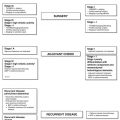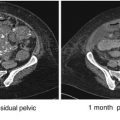PARP inhibitor
Company
PARP inhibition
Details
Olaparib (AZD2281)
AstraZeneca
PARP 1/2/3
Licensed in EU for maintenance BRCAm; ≥3rd line (FDA) in BRCAm. Phase III trials with tablet formulation – first line (SOLO-1) and maintenance in ‘platinum-sensitive’ recurrence (SOLO-2)
Rucaparib (AG-014699; CO-338)
Clovis oncology
PARP 1/2
Ongoing phase II and III studies in BRCAm, BRCAwt (ARIEL2; ARIEL3)
Veliparib (ABT-888)
AbbVie
PARP 1/2
First line phase III planned with chemotherapy
Niraparib (MK4827)
Tesaro
PARP 1/2
Ongoing phase III (NOVA) maintenance in BRCAm and BRCAwt; plans for first line
Talazoparib (BMN-673)
BioMarin Pharmaceutical
PARP 1/2
Ovarian cancer strategy unclear
Challenges for Integrating PARP Inhibitors into Clinical Care
In the EU, olaparib is now licensed for maintenance therapy in BRCA-mutated HGSOC that has responded to platinum-based therapy. The licence is based on the analysis of the BRCA-mutated population in study 19 and includes those patients with a somatic mutation. This indication has not been accepted by the FDA in the USA, where the licence for olaparib is for single-agent therapy in patients with a BRCA mutation and active disease in need of treatment. The indication is based on an ‘unmet need’ in this group of women who have received 3 or more lines of chemotherapy and is derived from composite data from 223 patients with a germ-line BRCA mutation, 137 of whom had measurable disease (FDA olaparib data). The details of some of these patients are described in the 193 patients in the ovarian cohort in ‘study 42’. The response rate was 34 % and the median progression-free survival was 7.9 months [32]. These two differing indications can be a source of confusion for some patients and indeed physicians outside the EU and USA. However, there is for the first time a molecularly targeted therapy for ovarian cancer based on genomics – the presence of a BRCA mutation. Although the cost of treatment is high, it is only applicable to a relatively small population of women with ovarian cancer. It is also clear that BRCA mutations have historically been under-diagnosed, and strategies need to be developed to ensure that patients with high-grade tumours are tested for a BRCA mutation. This is not as simple as it sounds. Historically, the responsibility for testing for germ-line mutations has been with cancer genetics departments; the indications are based largely on family history and the aim is to identify unaffected relatives. As we now know that the absence of family history is a poor negative predictor for a positive test, there needs to be a more widespread programme to test all patients. For some funders, this represents a significant resource issue. Although the cost of testing for a BRCA mutation is falling, many genetics departments do not have the resources to see and test all patients. For this reason in many areas, locally arranged consent and testing are performed within the context of gynaecology/oncology clinics, and only patients who are tested positive are referred to genetics departments for counselling so that a decision can be made about family testing. Opinion varies about the best time to test for a BRCA mutation, but it should be done either at diagnosis or after the completion of first-line therapy so that information is available at the time of first recurrence. There is also no consensus on the age limit of gene testing. The probability of detecting a germ-line BRCA-positive tumour falls off beyond the age of 60 years; there will be an even lower probability of finding a germ-line BRCA gene mutation in women over 70 years. However, testing only for germ-line mutations will miss somatic mutations estimated to be present in 6–8 % of tumours. For this reason, some advocate tumour testing of all patients with germ-line testing of those women who have a BRC mutation in the tumour. This presents additional resource and logistic issues that will need to be addressed.
Future Directions for PARP Inhibitor Therapy
Within a few years the results of three additional maintenance therapy trials in patients with ‘platinum-sensitive tumours’ (SOLO-2, NOVA, ARIEL3) will be available. In addition, the trials with niraparib and rucaparib will report on the use of maintenance therapy in patients without a BRCA mutation who are ‘BRCA-like’ by virtue of impaired HRR. Ongoing studies with rucaparib in BRCA-mutated tumours will provide a greater body of evidence of single-agent activity of this drug [29]. The results of the SOLO-1 trial, a randomised placebo-controlled trial of 2 years of maintenance olaparib following first-line therapy in patients with a BRCA mutation, will also be available. If this trial is positive, there will be three situations where olaparib can be used, creating a challenge for clinicians to select the appropriate time to use this drug. The results so far have shown that resistance to PARP inhibitors occurs in most patients with recurrent ovarian cancer. In a few situations, it has been shown that a revertant (functional) mutation occurs [33], but its importance as a factor underlying resistance to PARP inhibitors is unknown. Patients will respond to further chemotherapy after becoming resistant to a PARP inhibitor [34]. Following patients to the time of a second subsequent treatment after the treatment following failure of olaparib has shown that a benefit from the drug is maintained during subsequent treatment [24]. More information will emerge as the ongoing maintenance trials will measure the ‘PFS2’, the second progression-free survival after the subsequent treatment following progression on the trial drug. It is unknown whether patients will respond again to a (different) PARP inhibitor at a later point in their treatment, and it is important that strategies such as this are explored. Not all PARP inhibitors have an identical mode of action or potency. For example, in vitro data have shown that talazoparib (BMN-673) has greater potency than several other PARP inhibitors [35].
It is also becoming clear that there may be opportunities to combine PARP inhibitors with other molecularly targeted therapies. Synergy has been demonstrated between anti-angiogenic agents and PARP inhibitors [36]. The first indications of an additive or synergistic effect have come from a randomised trial comparing olaparib with a combination of cediranib, a VEGF receptor tyrosine kinase inhibitor [37] and olaparib in women with ‘platinum-sensitive’ relapsed ovarian cancer. The PFS was significantly improved in women receiving the combination and the magnitude of the effect was similar to that seen with conventional cytotoxic drugs. Trials are being planned to explore this combination further. One conducted through the NCI-CTEP will compare the combination with platinum-based chemotherapy, and the other, a UK-led study (ICON 9), will investigate the combination in a maintenance setting after chemotherapy. There are data to show that olaparib can be given safely with bevacizumab [38], and there will soon be a first-line trial (PAOLA-1) to evaluate the effect of adding olaparib to bevacizumab during the maintenance phase of treatment. Studies combining bevacizumab with niraparib in the second-line setting are also being planned. Other molecularly targeted agents, particularly those interfering with cell cycle replication, present additional opportunities for combination studies, and these are under discussion.
In summary, it is now clear that a BRCA mutation is the first predictive marker for molecularly targeted therapy of ovarian cancer and that PARP inhibitors represent a highly active new class of drug for this disease. The indication for their use will most likely expand, particularly if reliable predictive markers for defective HRR are found. The results so far have clearly demonstrated that treatment of ovarian cancer needs to be tailored to its biology.
References







